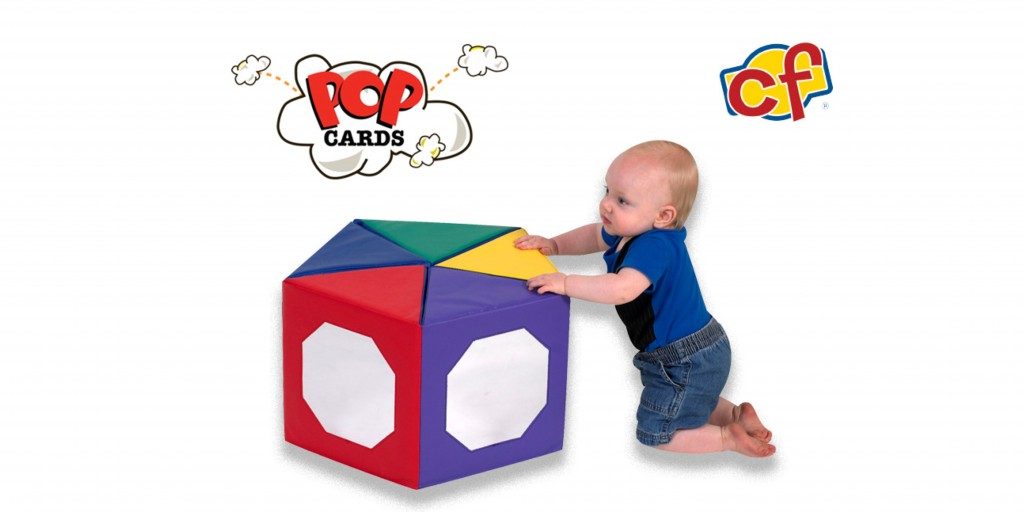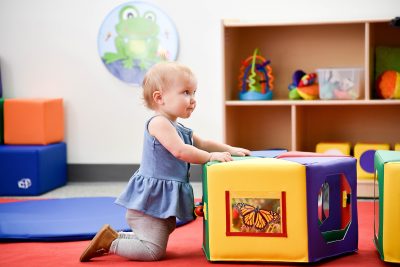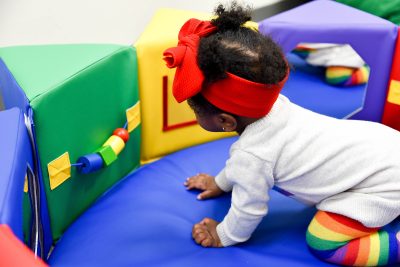
Lesson Plan: See the Baby?
POWER OF PLAY (POP)
“Play is the essential ingredient, the vehicle by which children communicate, socialize, and learn about the world around them, understand themselves and others, deal with their problems, and practice some of the skills they will use in the future” (Hartley, 1971)
Environmental Set-up:

Safe tummy time mirrors keep tikes engaged for hours as they learn self-recognition and learn to focus their eyes. Pictured here: Multi-Activity Pentagon Set.
Mirrors provoke curiosity and spark interest for the developing infant.
- Identify a “safe place” on the floor with a mat, carpet or soft blanket;
- Unfold Pentagon Mirror into an open semicircle with mirrors facing inside.
Objectives:
- Exploratory play
- Improved (core) trunk strength and stability
Activity Overview:
Place the infant (on his/her tummy) on the blanket/mat in front of the mirrors so that his/her reflections encourage him to rise up onto flexed or extended arms. You may also support the infant with your hand under his tummy. In this approach, you can move the infant back and forth in front of the five mirrors.
- To increase infant’s comfort for being on his tummy, get down on his level and play with him.
- Talk to infant to encourage engagement with the “baby” in the mirror.
- Encourage patting and playing with image in mirror.
Guiding Questions:
“Look! There’s the baby.”
“I see baby.” “Pat the baby’s head.” “Where’s [name of baby]?”
This is an important time for the infant to learn about his body and for gaining control over gravity. Through sensory-motor experiences, the brain is learning how the world looks, feels, sounds, and smells. These experiences differ as the body moves through space. The infant brain is learning how to control movements for reaching out to touch any one of the images, and for positioning the body and head in different ways to get different experiences of the external world when engaging with the mirrors.

The Multi-Activity Pentagon Set wow’s littles ones with plenty of sensory fun. Set features blocks, shatter-resistant mirrors, and plastic sleeves to hold images of each baby’s favorite pets or relatives.
This learning contributes to the basic sensory-motor “alphabet” of the child’s experience that will later come together to form a more complete internal picture of the external world.
Developmental Learning Outcomes:
Sensory-Motor/Physical Development:
- Strengthening of trunk and neck muscles
- Visual awareness of self and body
Cognition Development:
- Purposely repeats actions for the sensory-motor experience
- Interest in actions of image and responds with gestures
Language:
- Expanding expressive language: squealing & laughter
- Turns to voice; responds to own name
Social/Emotional Development:
- Smiles at reflection
- Responds playfully to mirror images
Activity Variation:
- Place a small rolled towel under infant’s chest for support when he is not yet able to support on own arms.
- Place infant in sitting position (supported sitting, if appropriate) in front of mirrors.
Resources:
Brazelton, T.B. (1983). Infants and mothers: Difference in development. NewYork: Dell Publishing.
Rationale:
The visual images enhance the infant’s awareness of himself and his body as he continues to learn what his body can do. While most play occurs while the infant is on his back, time on his tummy is important in developing trunk (back and neck) muscles for upright posture and mobility.